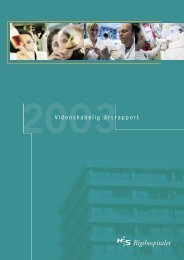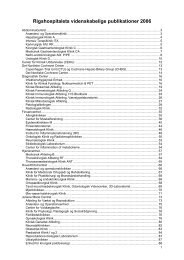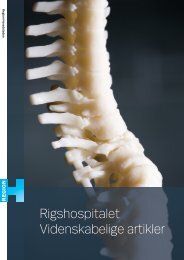View - CTU
View - CTU
View - CTU
You also want an ePaper? Increase the reach of your titles
YUMPU automatically turns print PDFs into web optimized ePapers that Google loves.
ished in a lower number<br />
techniques [y = -0.15; P<br />
her nickel-titanium hand<br />
systems [y = -0.25; P =<br />
at all in any of the new<br />
{IV).<br />
%)<br />
Aseptic operation field and rubber dam<br />
The GDPs' confidence in performing endodontic treatment in relation to a mandibular<br />
molar varied, but was relatively high, expressed as VAS scores below 50. When<br />
mean comparisons of the VAS scores were compared, the creation of an aseptic<br />
operation field was regarded as the most difficult procedure (Study II). In the urban<br />
GDP population only 4% were frequent users of rubber dam, and 14% used rubber<br />
dam occasionally (Study IV). However, a technology cluster was observed, as<br />
frequent rubber dam application was correlated with the adoption of nickel-titanium<br />
hand instruments [y = 0.24; P = 0.003], nickel-titanium rotary systems [y = 0.50; P <<br />
0.0005] and warm gutta-percha techniques [y = 0.29; P = 0.0005]. The use or nonuse<br />
of rubber dam was not noted in a single Dental Complaints Board related to an<br />
endodontic malpractice claim (Study VI).<br />
2 GDPs. NiTi denotes nickelrnational<br />
Endodontic Journal,<br />
:lge and skills disclosed<br />
ng at a non-satisfactory<br />
I 'root filling procedure'.<br />
hesia' and 'emergency<br />
Cl*)<br />
(I*)<br />
(1*}<br />
Nousati.~/(1cto1·y<br />
Total (t7"1<br />
M<br />
28 (6.3) 7<br />
182 (40.8) 96<br />
2 (0.4) l<br />
5 (1.1) 0<br />
5 (I. I)<br />
24 (5.3) 14<br />
27 (6.0) 19<br />
34 (7.7) 15<br />
F<br />
No<br />
il~iiuc11n·<br />
21 23<br />
86 24<br />
I 20<br />
5 19<br />
3 25<br />
10 19<br />
8 19<br />
19 26<br />
~nts' of level of endodontic<br />
ith permission from OOOOE,<br />
Microbiology and endodontic prognosis<br />
The gold standard regarded the preoperative presence or not of microorganisms to<br />
be all important as evidenced by their high-lighting of 'periapical status' and 'infected<br />
root canal' to have a particular influence on the endodontic prognosis (Study V). In<br />
contrast, the GDPs highlighted 9 out of 12 preoperative factors as having a relatively<br />
high influence (VAS scores > 50) on the outcome of endodontic treatment (Fig. 8).<br />
Furthermore, -40% of the GDPs regarded their microbiological knowledge as not up<br />
to standard (Table 7).<br />
GDP graduation year/age<br />
Dentists from the early graduation years performed fewer endodontic treatments per<br />
week than dentists in the later group (Study IV). Younger dentists compared to older<br />
scored a higher influence on treatment outcome in relation to 'status of the pulp' and<br />
'periapical status', 'interappointment dressing in treatment of the necrotic infected<br />
pulp' and 'presence of bacteria in the root canal after completion of instrumentation'<br />
(Study V).<br />
29








